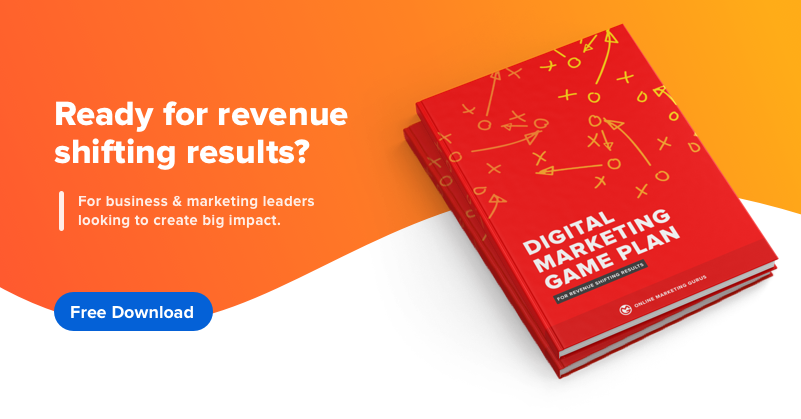How to Level Up Your Social Media Marketing Strategy in 2022 


What if we told you that you could explode your online presence and reach millions of customers where they spend their time online?
That’s just ONE of the powers that social media advertising gives you.
Social media marketing is a great way to take your brand awareness to new heights, bring in FLOODS of customers, and build an ongoing relationship with your existing ones.
But that doesn’t mean that social media management is easy or straightforward. And it SURE doesn’t mean that you’re guaranteed sky-high ROI.
Heck, if you’re struggling with your social media marketing strategy, we get it.
So what’s the recipe for social media marketing success in 2022?
It begins and ends with an evidence-based approach — and that’s exactly what we’re going to explore here in this step-by-step guide.
If you want to level up your social media marketing strategy in 2022 and see tangible results that you can take to the bank, read on.
What is social media marketing?
Social media marketing involves using a social media platform to connect with your target audience online. Brands can use social media to build brand awareness, drive traffic to their website, generate sales, and increase engagement with new and existing customers.
There are two forms of social media marketing: organic social media marketing, and paid social advertising.
- Organic social media marketing involves reaching your audience through the free means available on the social network. This could include adding an image gallery to your Facebook page, adding a video to your Stories, sharing a blog post on LinkedIn, or adding products to your posts through Shopping.
- Paid social media marketing includes any action where you pay to promote your brand on social media, and operate on a bidding system. Some of the most popular types of paid social media ads include branded content, sponsored posts, Sponsored Stories and Sponsored InMails.
You need to have both if you want to create a bulletproof social media marketing strategy that feeds into every step of your marketing funnel.
Creating a social media marketing strategy: the fundamentals
1. Set the right goals
One of the biggest reasons that marketers feel lost on social media isn’t targeting, content, or even ad spend.
It begins LONG before that.
It’s because their objectives don’t match the end-game.
Coming up with a killer social media marketing strategy means having your goals in place before you make the game plan — and ensuring they tie in to your broader business goals.
Let’s take an example.
Say you’re a local restaurant that’s looking to scale in 2022. To grow your business, you need to find new customers and bring them in to sample your food. However, if you’re constantly posting content on social media to the same followers, chances are you’re not reaching new people that will come in and dine with you.
Take a good hard look at your business goals, and consider where your social media strategy fits into the broader puzzle.
It could be:
- Improving loyalty with your existing customers through engagement and repeat purchases
- Driving more qualified web traffic to your website
- Increasing brand awareness and reach with new followers
- Delivering a first-class customer experience with news and updates
Once you’re crystal clear about your social media goals, the rest becomes much, MUCH easier.
2. Pick the right social media platforms
The right social media channel makes a HUGE difference. There’s no point investing your time and resources into advertising on Instagram if you’re trying to get white-collar workers to download an eBook. The same goes for posting mouth-watering snaps from your cafe on LinkedIn.
So how do you select the right social networks for your business?
Easy: let the numbers be your guide. Each social media platform has a specific user demographic, and a specific set of benefits it offers as a marketing channel. It all comes down to looking at what the platform offers and who its audience is, then matching this up with yours (more on this later).
A final word of advice: if in doubt, focus a single social media platform first. It’s far better to do one platform well than to be on every channel and do none well.
3. Establish your KPIs
Like the first step, your KPIs are CRITICAL to social media marketing success. An evidence-based social media marketing strategy will help your brand tackle its goals with a sense of purpose, while also giving you a benchmark to measure your success.
One of the biggest mistakes brands make is not tracking social media metrics, or tracking only vanity numbers, such as followers or likes.
Dig deeper to uncover the metrics that matter to your business — and we mean REALLY matter. For example:
- How many users are coming through to your website from social media
- Engagement (the total number of social interactions divided by the number of impressions your post received)
- Reach and impressions for your posts
- Mentions of your brand on social media
4. Keep an eye on the competition
Social media is a BUSY space. There are a lot of brands out there vying for the same users, which means you need to know what your competitors are posting, in order to stand out.
Luckily, there are plenty of ways you can stay on top of other brands:
- Follow them on social media
- Set up social listening for competitors on your social media management platform
- Browse Ad Library to see which ads they’re running
- Run a search for their brand name and hashtag
5. Post and engage with your audience regularly
All social platforms are driven by content.
In fact, it’s built right into the algorithm.
If you’re not posting regularly, you’ll lose your reach and your followers will be less likely to see your content in the future — not to mention your brand will slowly but surely slip to the back of peoples’ minds.
On top of sticking to a consistent posting schedule as part of your social strategy, you should be interacting with your followers. Make sure to respond to comments ASAP, have your customer service team reply to messages, and comment on any images where your brand or product is tagged.
6. Review and optimize
Like any digital marketing channel, there’s no one-size-fits-all approach. You need to regularly review your performance to understand who your target audience is, which posts work well, when to post, and so on.
Monitoring your performance metrics allows you to be reactive and get the most out of your campaigns in the short term, while ensuring your social media outcomes are lining up with your broader business objectives in the long term.
Read our Facebook Ads Audit and Optimisation Checklist to see how you can take your Facebook marketing to the next level.
What are the advantages of using social media advertising?
As we touched on earlier, you need to have an organic and paid social media marketing strategy if you want to truly unlock the potential of this channel.
While you can technically just rely on organic reach, it’s rough out there. Organic reach is declining fast, and social algorithms can change in a heartbeat — leaving your business performance wildly susceptible to any changes that spring up. Today, you might get a ton of engagement. Tomorrow, none at all.
Plus, even if you’re killing it now, at some point you’ll hit a glass ceiling with your growth. It becomes tougher and tougher to scale and reach new audiences day in, day out.
Done right, paid social media takes a lot of the unpredictability out of social media marketing, allowing you to charge full speed ahead towards your business goals.
First up, it’s hyper-targeted.
Social media ads allow you to hone in and get as granular as you’d like in terms of who you want to target.
Want to reach mums living in South Australia who look like your existing customers on Instagram? Go for it. Looking to present a special offer for professionals at the management and executive level using LinkedIn Inmail? Easy.
As long as there are enough people out there for your ad to get served up to, the WORLD is your oyster in terms of targeting. At the end of the day, this means you can ensure your ads are seen by the right people: the ones that are most likely to buy your products and services.
Paid social ads bring more traffic, more leads and more sales.
Each social media platform has different ad formats depending on your goals, from the ability to direct customers to your website using a strong call-to-action to increasing your number of followers or promoting your products through a carousel. It’s the missing link between your social media marketing strategy and your broader business strategy.
It’s measurable.
You can literally track EVERYTHING, from the number of visitors who clicked through to your website from an ad to your cost-per-click, reach, and the users that were most likely to engage with your brand. In the right hands, this information is an absolute gold mine. It can be used to optimize your targeting, refine your content and ultimately get incredible ROI.
Best social channels for marketing
New social media channels are springing up every day, but the top social channels have remained relatively unchanged over the years.
If you want to elevate your marketing, you need to have a social presence on either Facebook, Instagram or LinkedIn — or a combination of the three. These are hands down the best social media channels for marketing and, done right, a powerhouse for engagement, traffic, leads and sales.
So how do you pick the right one? We deep dive into the benefits of all three, as well as explore which type of business works best on each platform.
Benefits of Facebook
- Diverse content formats. Facebook has an almost ENDLESS list of different post and ad formats, which makes it the most versatile platform out there for social media marketing. On top of the basic image, video and link posts, you can make Carousels, Instant Experiences, Product Collections — which means there are a ton of ways to increase engagement, traffic and sales from your content.
- It’s one of the world’s biggest social networks. 2.7 billion users actively use Facebook. If you want to reach as many people as possible with your brand, this platform is undeniably the best way to do so.
- Its user base is broad. Facebook’s demographics cover the widest ground of any social media network out there. Young, old, and every age in between — everyone can be found here, which makes it easier to target your audience or reach different segments on the same platform.
Which brands should use Facebook?
If you’re not sure which platform to use, this is probably your safest bet as you’re likely to find a large percentage of your target audience on this platform. As a bonus, you can kill two birds with one stone with Facebook Ads, and advertise your business on Facebook AND Instagram.
Benefits of Instagram
- It’s incredibly visual. If you’re selling beautiful products or services, then this is the perfect place to show off your goods. People come on Instagram to browse through engaging videos and images, so you have the best chance of converting them to customers if your products look amazing.
- The audience skews younger and female. While the people on here aren’t as young as TikTok or Snapchat, Instagram’s users are pretty heavily concentrated in the 18-35 year old bracket. More women are also on Instagram compared to men, which makes it ideal if this is your target demographic.
- Instagram Shopping. Instagram Shopping is definitely the best shopping tool of all the mainstream social media platforms. If you have this feature enabled, you can add a link to your products on every social media post, which makes it CRAZY easy for your followers to click through and buy any products they like.
Which brands should use Instagram?
Like Facebook, Instagram covers a pretty broad audience. If you have a product or service that looks great, like a restaurant or an eCommerce store, you’d be doing yourself a disservice NOT to use Instagram. This is also the perfect pick if your target audience skews younger or more female.
Benefits of LinkedIn
- It’s a niche platform. LinkedIn was designed with a specific goal in mind: to help professionals network, learn, and find jobs. With over 675 million users, this is single-handedly the world’s largest and most effective platform to reach this audience.
- LinkedIn users are influential. 4 in 5 LinkedIn users drive business choices in their organization, making it the perfect place to go if you want to increase brand awareness amongst key decision-makers.
- Laser-focused advertising. On top of already being a niche platform, LinkedIn Advertising gives brands access to a ton of powerful advertising features. You can target an audience by job title or industry, upload your existing contacts, or send a message directly to a user’s LinkedIn inbox with Sponsored InMail.
Which brands should use LinkedIn?
If you’re a B2B business looking for leads, LinkedIn was made for you. 62% of B2B marketers say LinkedIn generates leads, which is over two times more than the next-highest social channel. However, LinkedIn advertising is typically more expensive than other platforms, so you NEED to have a sharp strategy in place to get solid returns.
How to create a social media content strategy
The secret to killer social media marketing strategies?
High-quality content.
It doesn’t matter which social media platforms you’re using, or who your target audience is.
Content is king.
So how do you create and share the right social content for your followers?
1. Know the platform
Every social media channel is different. The most effective content on LinkedIn isn’t the same as Facebook. Likewise, what works on Facebook will probably fall flat on Instagram.
Get to really know the platform BEFORE you create a social media page for your business. Take time to observe your target audience, see how they’re posting, what hashtags they’re using, and the types of content they engage with and share (such as videos, images, blog posts, and so on). This will help you get started on the right foot with your social media marketing plan.
2. Stick to social media content themes
The best brands on social media all have this thing in common: they’re consistent with the type of content they post.
For example, Xero does a great job in using LinkedIn to help share company news, advice for small businesses, and customer profiles:
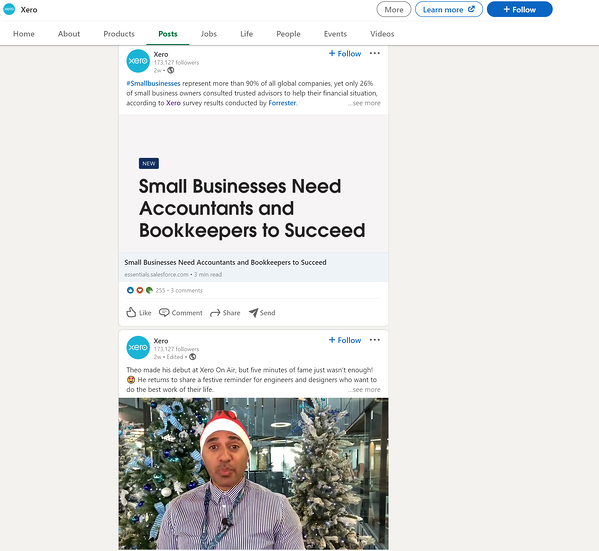
Focus on key content pillars and types of content for your social media marketing strategy: for example, share user-generated content, product videos, customer reviews, and a ‘how to’ guide once a week.
Another option is to stick to creating content with a color theme, like Seafolly:
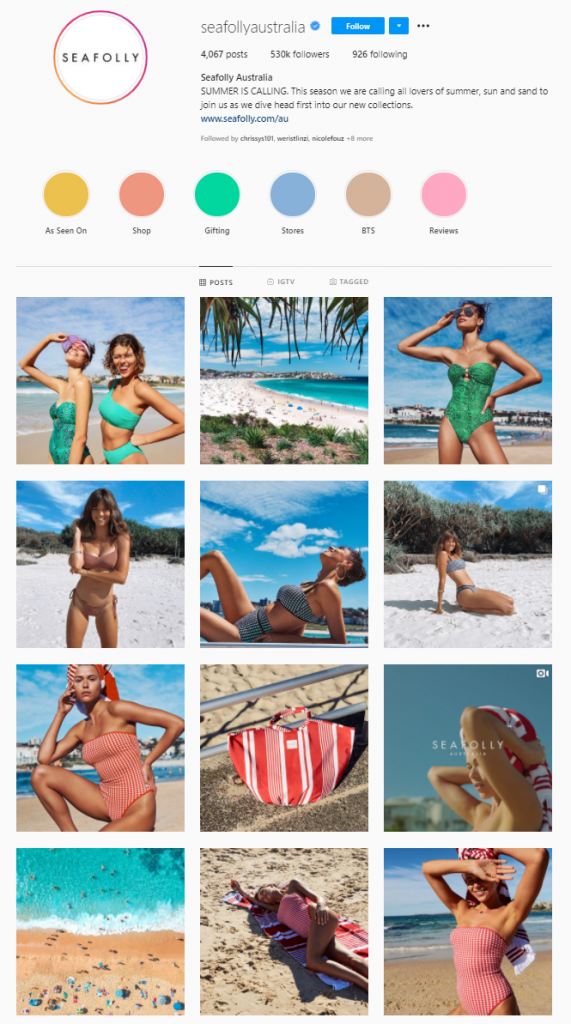
Try to schedule your posts in advance as well, if possible. This ensures you tick off all the different themes in your content calendar, and can also help you visualise how your posts appear in the feed.
3. Share user-generated content (UGC)
It’s great to have beautiful branded content, but it’s even better when your existing customers do the selling for you. UGC is a fantastic way to add social proof to your brand, while engaging with your current customers by sharing their images.
Starbucks does this incredibly well:
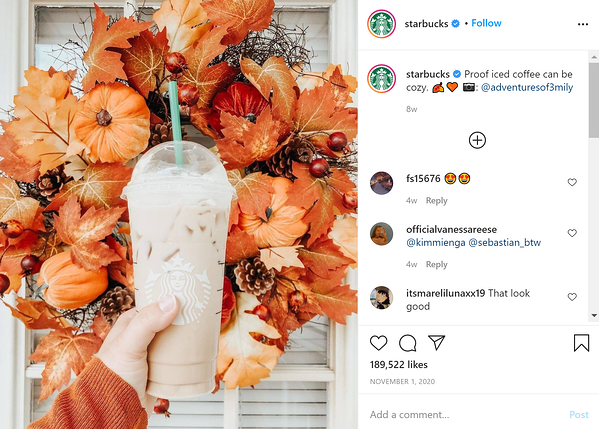
Tip: comment on posts that your users share, even if you don’t share it on your official account. A simple “Thanks for sharing” can make a huge difference in terms of brand sentiment and engagement.
4. Use Stories
Social media is all about timely and relevant content. Needless to say, FOMO goes a LONG way on networks such as Facebook or Instagram, which is why Stories are a great tool to increase engagement and awareness with people.
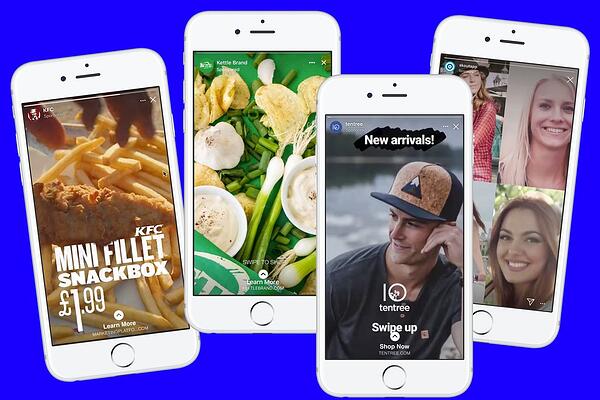
Try to use Stories whenever possible in your content strategy. If you’re stuck for ideas, here are a few to help get you started:
- Behind-the-scenes content
- Teaser for new product launches
- Share user-generated content from real people
- Interviews or live streams of events
- Recipes or ‘how to’ guides
- Time-sensitive offers
The icing on the cake is that Stories also appear first on the newsfeed, which can help keep your brand top-of-mind amongst your social media followers all the time.
Unleash the power of social media marketing in 2022
Done well, social media marketing is a force to be reckoned with. But it’s by no means an easy task. You need to make sure you select the right social network for your target audience, create relevant and time-sensitive content, and run ultra-targeted paid campaigns that convert.
Ready to create a steady stream of leads and revenue from social media marketing, while also building up brand awareness and improving customer loyalty? Download our free digital marketing game plan today.
This 75-page guide will help you build a rock-solid social media strategy that reaches your target audience and delivers revenue-shifting results.


